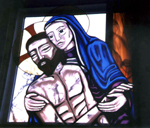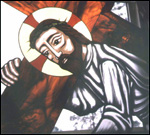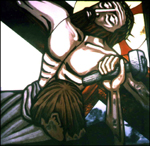Your school’s DNA is made up of stories. How are they told and retold? Your board members need multiple opportunities to make them their own. When your school’s stories are joined to theirs, your school and their lives are richer.

|

|

|
| The stations of the cross images are photographs of stained glass windows at Holy Trinity Episcopal Church in Hot Springs Village Arkansas. |
From the procession around the block on Palm Sunday, led by kids carrying the battered old papier-mâché donkey (with the pine-cone ears) and the cloth-sculpture Jesus (who often wears sneakers, because the kids can’t figure out how to make feet), to the all-night vigil on Saturday, which culminates in baptisms just as first sunlight yellows the windows, Holy Week at St. John’s Lutheran Church in Shenandoah, Pennsylvania, is deep in ancient rhythms of prayer. Some members take vacation time in order to delve more deeply into the mysteries.
St. John’s is the kind of small church where nothing ever gets thrown out (except for fifteen years’ worth of minutes from congregational meetings, but that’s another story). And one of the highlights of our Holy Week observance showed up about fifteen years ago in a little-used cupboard above the choir closet. A stack of hundreds of twelve-page folders, neatly stapled into purple construction paper covers long since faded brown at the corners, was tucked way in the back. They weren’t dated, and none of the older members remember using them, but only one former pastor, whose tenure was in the 1950s, had liturgical proclivities to match these.
“The Way of the Cross According to Lutheran Usage Compiled by the Evangelical Lutheran Church in British Guiana” looks a lot like the Roman Catholic and Anglican popular devotion stations of the cross. That form of prayer had its roots in the 1400s when the Franciscans began running the shrines in Jerusalem. For those who couldn’t make the pilgrimage, the friars set up walks around various European cities with stops at churches and monasteries to pray and reflect on the various torments Jesus suffered on his way to die. Eventually the whole thing moved indoors, involving fourteen small wood crosses and sometimes accompanying pictures or bas-reliefs arranged around the church.
St. John’s version follows the traditional pattern: opening prayers; then at each station a call and response, a description of the scene, silence, a prayer related to the scene, and a short series of prayers repeated at each station; and finally, closing prayers. The traditional fourteen stations are cut down to ten, with extra-biblical ones removed and some stories folded together. The language is florid—mawkish to some tastes.
And it is beloved. The first time we used it (sitting in a circle with a cross in the center as our sole visual focus) I watched the group around me slide into a state of quiet and visceral connection with the story I’d never seen before—and I realized we’d need to debrief. When we finished, I left the group in silence as I slipped out to turn on the coffeepot.
When I returned, they were silent still, and I quietly asked, “What got you?” One by one the participants told about the places where they had connected anew with an old story. Esther, who spent many years as head nurse in a Philadelphia emergency ward, said, “I never got past Jesus being stripped. It said, ‘His garments are torn from his bleeding body.’ I’d never thought of that, even after all the times I had to pull away clothes that were stuck on with dried blood.” Charlie got caught in blood imagery, too, with the words, “His blood has run in streams down his body.” Charlie is a Vietnam vet who has seen more than his share of blood, both on the battlefield and in hallucinations during a psychotic interlude shortly thereafter. Marie didn’t tell her story to the group, but pulled me aside later. She’s known more than her share of tragedy, one piece of which was the murder of her oldest son. Another piece left her angry at—of all people—Mary, Jesus’s mother. But now she said, “I never realized she has a murdered son, too!” Me? I was left, after a hard year, with the words from a prayer—“Most compassionate Lord, we adore thee dead and enclosed in thy holy sepulchre”—ringing in my heart for the rest of the week.
The experience is different every year. There are no consistently recurring themes in the participants’ responses. Once in a while someone doesn’t connect with any of it, finds it all supremely tedious. There’s no predicting how anyone will react to a new telling of an old story.
That’s worth remembering as you share stories of your school, as you seek God’s direction in your decision-making, as you do all the varied tasks of your board. People have depths you can’t imagine. People have been shaped and formed by things of which you have no knowledge, and it is good to listen to their stories, to learn their sorrows and their gifts. They deserve the opportunity to hear, to experience, the important stories more than one time, told more than one way.
And I know this. The more fully people enter into a story, the more truly they experience its climax. The people who come to stations on Monday night in Holy Week are the ones who spend the night on Saturday. And come dawn, they are the ones who are exhausted and flabbergasted and ecstatic—much like some disciples of an earlier era, very early on the first day of the week.
Resources
-
Olga's Gallery has photos of the sites in Jerusalem.
-
Beliefnet.com has a multimedia presentation.
-
The web site of Sacred Heart Catholic Church in Washington State has meditations by John Cardinal Henry Newman, among others, and a gallery of artwork illustrating the stations.